Sexy they’re not, but light sedans are cheaper and (mostly) better than ever. Here are four of the best.
Can’t wait to see the final scores? Jump to the verdict now.
LIKE most things that seemed like a good idea at the time, testing this assortment of stunted sedans started off as a joke of dubious taste.
Months ago, I facetiously suggested we ought to pitch Mitsubishi’s then-upcoming Mirage-based Attrage (for Attractive Mirage!) sedan against the redesigned Honda City, plus one other B-segment four-door rival, and call the test “Ménage Attrage”.
But the powers that be agreed that, with two keenly priced sedan newcomers tackling segment stalwarts such as the Hyundai Accent and Holden Barina, the comparo was indeed a goer. And then Mitsubishi jettisoned the Attrage name for Australia anyway, killing the joke completely.
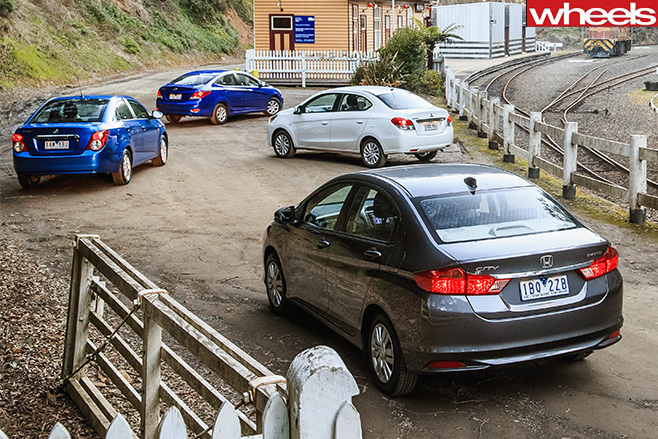
Welcome, then, to Wheels’ first-ever dedicated B-segment sedan comparo, presented in glorious full-colour automatic transmission form because that’s what the market wants.
Four for the money
But let’s not beat around the bush. Mitsubishi’s new Mirage sedan looks like it crawled from the primordial soup – skinny and slab-sided, with big headlights and a gaping mouth. Any semblance to the sassy 1996-2003 Mirage three-door is just that. It’s an epic visual fail.

On the other hand, being gormlessly tall and narrow, the Mitsubishi formally known as Attrage is easy to enter, especially its back section with bountiful rear-seat legroom. Other plus points include a large glovebox, a crystal-clear Bluetooth system (but, curiously, no USB outlet) and rear windows that drop all the way down – handy if your dog likes sticking its head out the window at speed.
The lack of telescopic steering adjustment (the column is tilt-only, as is the Accent’s), old-school air temperature slide controls and sparse analogue instrumentation are total 80s throwbacks. And while overhead grab handles and a rear centre armrest with cupholders are unexpected surprises, the lack of a folding backrest, reading lights, coat hooks and full-size spare (City is also guilty of the latter) reveal the true depth of the cost-cutting here.
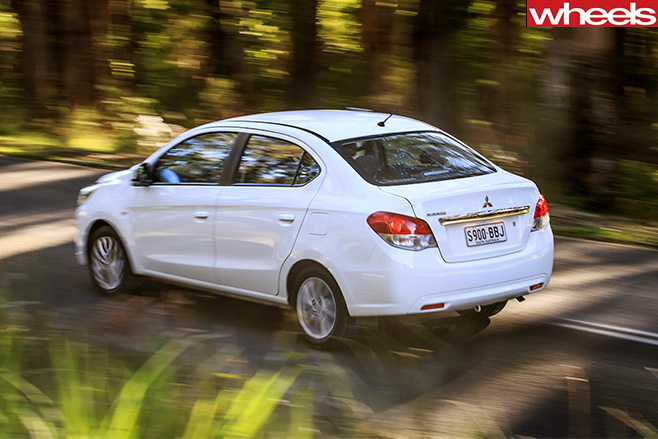
Sleekly contemporary in style, Honda’s $17,990 City VTi CVT seems upmarket and dignified by comparison – repugnant hubcaps aside. At least the City’s matte metallic-look plastics and piano-black dashboard finishes elevate its interior, backed up by the group’s only front centre armrest with storage, rear door bins and today’s must-have accessory – a reversing camera – as part of a central touchscreen unit with app capabilities. This one item underscores the City’s class-leading modernity.
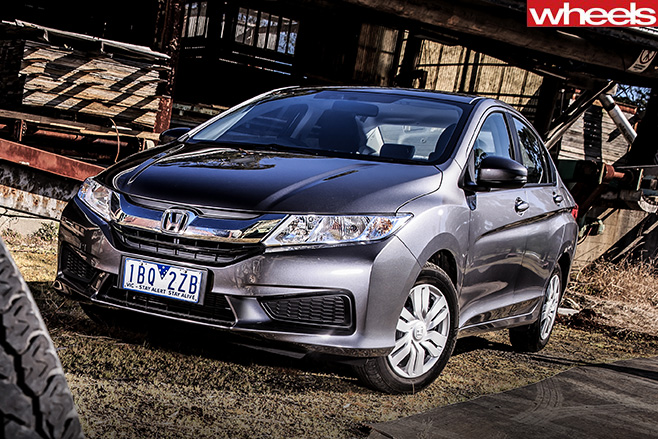
Firm but supportive seats and plenty of elbow space impart a sense of comfort, helped by the City’s relatively quiet drivetrain. However – and perhaps because of the latter – there’s quite a bit of road-noise intrusion when riding in the back.
The second most expensive sedan here – Holden’s $18,490 Barina CD automatic – boasts the most aggressive styling (by Aussie GM designer Ondrej Koromhaz), thanks to its chiselled nose and muscular wheelarches. It’s ironic considering the Barina’s entrenched hyper-fem image.

On the flipside, blighting our Barina’s cabin peace is a cacophony of cellophane sounds from one of its door trims, no rear-seat reading light and no centre armrest. Note also that the larger half of the split-fold backrest is on the driver’s side, forcing two passengers to exit road-side – a hangover from the car’s left-hand-drive origins. And everyone on test complained about a numb bum after driving the Barina. Also, its rear cushion is shapeless and passengers face sore shins from rubbing against the underside of the front-seat bases.
The oldest car here is Hyundai’s $18,990 Accent Active automatic, with an amorphous shape reminiscent of the old i45, Xeroxed down to 65 percent. The same applies to the car’s toweringly competent dashboard design and layout, featuring clear dials, user-friendly multimedia connectivity, a gigantic glovebox, classy illumination and ample cabin lighting. But why does the most expensive combatant here ignore cruise control and steering reach adjustment?
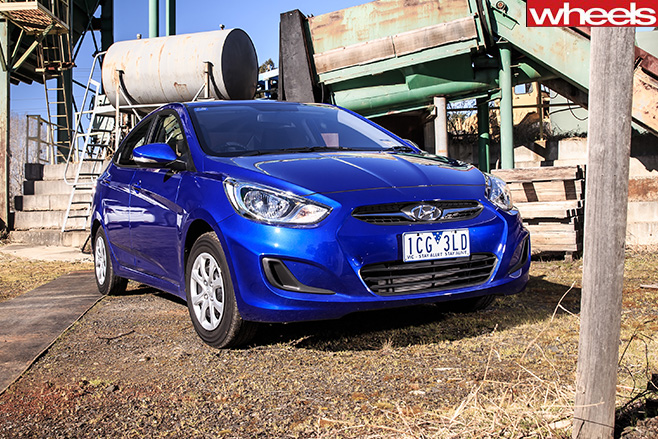
So how do they go?
There are also some anomalies under the bonnets of this quartet. Beginning with the newest to market, the Mirage might have only three naturally aspirated cylinders and a mere 57kW and 100Nm on hand, but that’s no real hindrance in a car that weighs just 940kg – easily the lightest of the four. If, like me, you relish the notion of a rorty triple, the Mitsubishi MIVEC unit obliges with a thrummy yet punchy power delivery right up to its 6500rpm redline. Indeed, the Mirage’s point-and-squirt eagerness is quite addictive, at least with the standard manual gearbox.
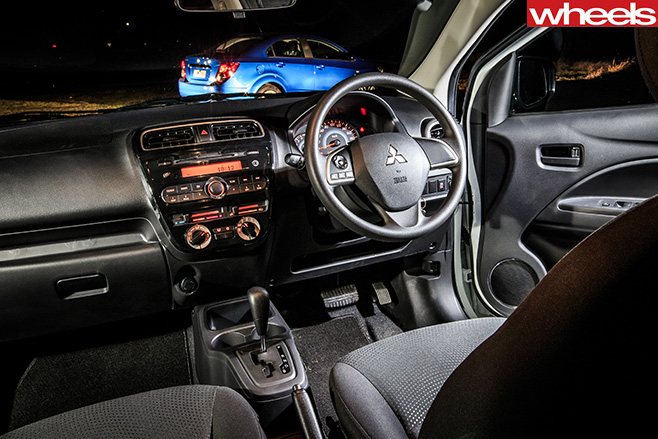
Nobody will be surprised to learn that a 14.5sec amble to 100km/h (recorded for all four cars with two occupants rather than the usual one due to a broken data-box mount) makes the Mitsubishi the segment’s slug. Add more passengers or a gradient and the Mirage’s pedal needs to be mashed to the floor, especially at highway speeds, for momentum to be sufficiently maintained. Inevitably, this hurts consumption, resulting in a second-placed 8.8L/100km average, somewhat more than the official combined average of 4.9L/100km.
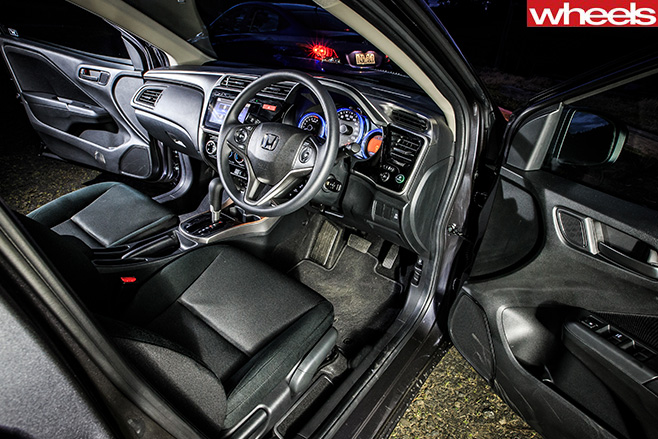
Mated to an all-new CVT transmission that replaces an outdated five-speed torque-converter auto, the City is quick off the mark and maintains its accelerative urge all the way to 6600rpm, responding to throttle inputs with minimal delay. This is the sort of zingy and zestful engine for which Honda is renowned, and adding two adults in the rear hardly registered on the performance front, either.
It’s also far and away the smoothest drivetrain here – so much so that road noise is quite noticeable due to the lack of thrashy mechanical intrusion that inflicts the others to varying degrees.
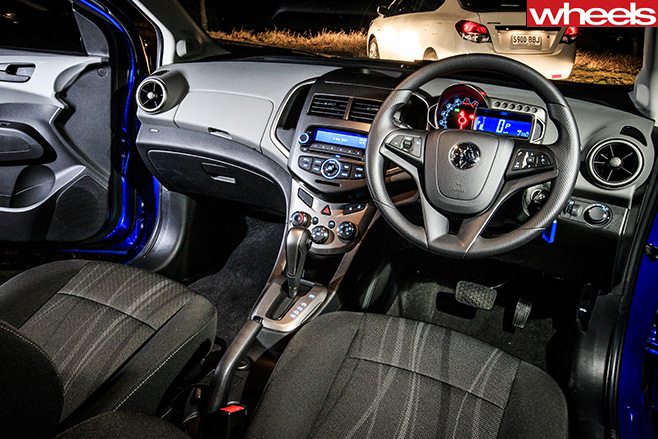
Ideal for zipping around town, the engine’s power delivery falls into a chasm just when you need to overtake on the open road, the transmission hesitating before finally discovering a lower gear, accompanied by a crude induction racket beyond about 4000rpm. Along with Mirage, the Barina auto failed to reach 140km/h in the available distance at Tooradin airstrip, while the 13.1sec it took to reach 100km/h betrays a 95kg weight penalty over Honda’s lithe City.
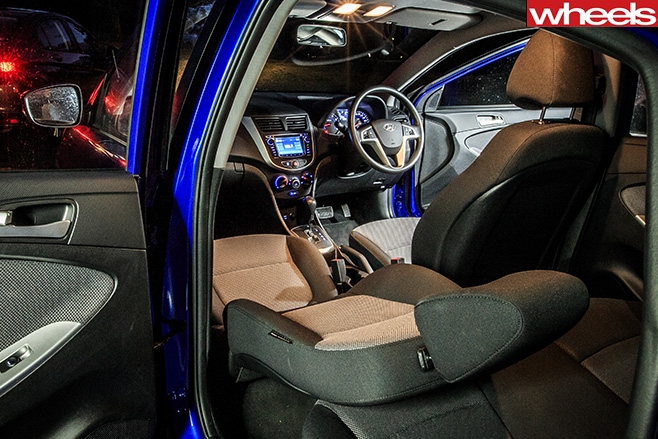
Steering, ride and roadholding
Following its inferior drivetrain performance, we didn’t expect the Barina to have the best steering, most entertaining handling and quietest ride. But Lang Lang’s dynamics team have earned their keep, with a little help from the best tyres in the group (Continentals), and the only hydraulic rather than electric-powered steering.
For weight, feel and turn-in response, the Barina blitzes the rest, keeping its driver informed with what’s going on up front while maintaining proper body control. There’s a caveat here, though. At higher speeds, through tight turns and arcing corners alike, the Holden’s sharp steering can at times feel nervous to the uninitiated.
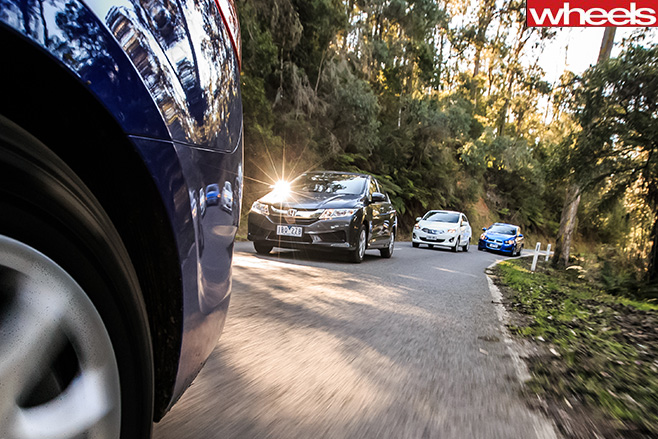
Dynamically, the Accent is a by-the-numbers operator, walking the middle ground between agility and security, being neither too light nor too sharp. It’s very easy to drive, aided by an eager traction-control system and the group’s most powerful brakes (the only one with rear discs), but the Hyundai’s remoteness leaves the keen driver stone cold. It is deathly dull.
Then there’s the Mirage. Compared to the dynamically underdone hatch, the sedan benefits from a 100mm-longer wheelbase and wider tracks, which have improved its manners markedly. With so little power to corrupt the front end, the Mitsubishi is a doddle to drive flat-out, its chassis gripping gamely despite increasingly dramatic body roll until it progressively succumbs to messy understeer. It’s strangely entertaining and entirely incongruous, as well as oddly endearing.
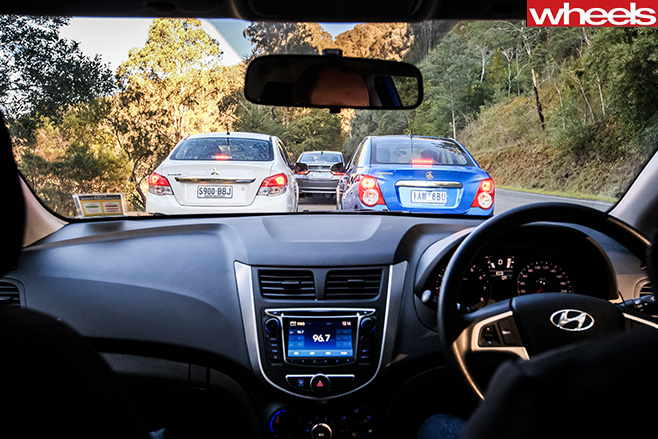
Where to spend your money
Ultimately, one light sedan shines brightest in this group test. The Honda City VTi scores a well-deserved victory. It is contemporary, spritely, economical, spacious, well-equipped and very keenly priced. It is another sign that Honda is at last reviving its once-enviable reputation, even though the City’s steering feel remains as lifeless as Honda’s recent sales performance.
Separating second and third is a close call. The Accent’s $1000 price premium over the next-dearest rival here is offset by this group’s most affordable servicing, the most grown-up dashboard design and its ease of operation – all admirable attributes. But the uninspired Hyundai is curiously uninvolving to drive, imparts a rental-car ambience, inflicts a fidgety ride, and suffers surprising specification shortfalls.
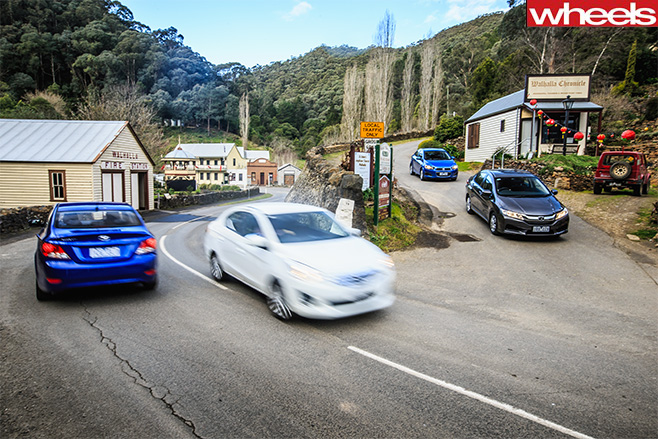
Which leaves the Mirage way off the pace, literally as well as metaphorically. Its price advantage is completely overshadowed by its third-world interior, dreary performance, odd packaging, equipment anomalies and dire lack of refinement.
Cheapness doesn’t necessarily equal value. People who venerated iconic older Mitsubishis such as the Colt, Sigma, Galant, Nimbus, Magna and previous Mirage would be horrified.
A joke involving the Mirage may have instigated this comparison, but its last-place finish is no laughing matter, revealing a depressing low for a company brimming with a proud heritage. The diamond brand is wilfully turning into a cubic zirconia and we’re heartbroken. Please reconsider, Mitsubishi.
VERDICT
Holden Barina CD
Price as tested: $18,490
NCAP rating: 5 stars (Aus)
Fuel economy: 9.5L/100km (test average)
Acceleration: 0-100km/h: 13.1sec (tested)
Plus: Sharp handling, controlled ride, solid feel, intuitive multimedia system
Minus: Noisy, thirsty, breathless at speed, gearing holes, poor seats
Verdict: 6.0/10
Honda City VTi
Price as tested: $18,485
NCAP rating: Not tested
Fuel economy: 7.9L/100km (test average)
Acceleration: 0-100km/h: 10.7sec (tested)
Plus: Performance, economy, dash layout, rear camera, massive boot
Minus: Rear headroom, some road noise, poor warranty/service intervals
Verdict: 7.0/10
Hyundai Accent Active
Price as tested: $19,485
NCAP rating: 5 stars (Euro)
Fuel economy: 8.8L/100km (test average)
Acceleration: 0-100km/h: 11.4sec (tested)
Plus: Dashboard design, cabin space, warranty/service costs, rear discs
Minus: Harsh at speed, expensive, ancient auto, no cruise, tilt-only wheel
Verdict: 6.0/10
Mitsubishi Mirage ES
Price as tested: $16,490
NCAP rating: 5 stars (Euro)
Fuel economy: 8.1L/100km (test average)
Acceleration: 0-100km/h: 14.5sec (tested)
Plus: Rorty engine, okay ride, low price, long warranty, rear-seat legroom
Minus: Slow, noisy, no folding rear seat, cheap cabin, meagre spec, resale
Verdict: 4.0/10





